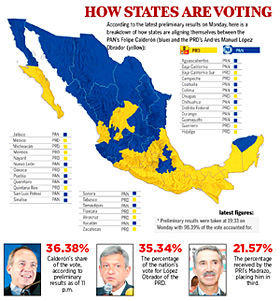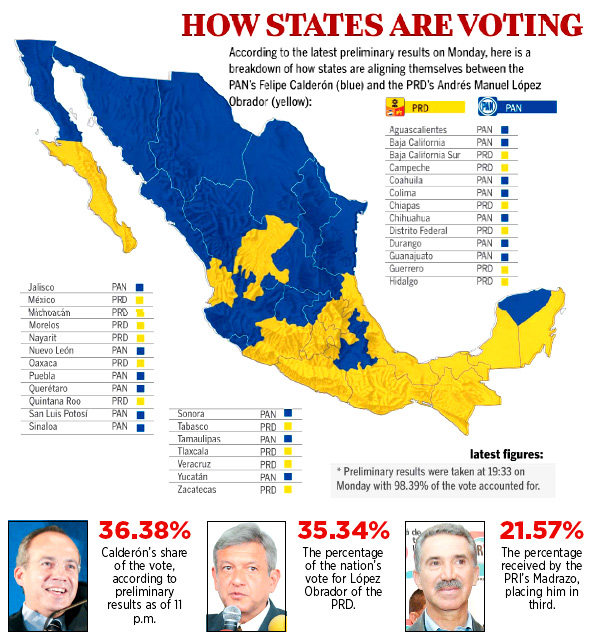 |
 |
 |
 Editorials | July 2006 Editorials | July 2006  
Contest Reveals New Split in Nation
 Kelly Arthur Garrett - The Herald Mexico Kelly Arthur Garrett - The Herald Mexico


| | See larger image below |
No matter who takes home the presidency, the 2006 national elections have already described a new political landscape in Mexico.

The microscopic margin deciding the next president suggests troubling scenarios for his effectiveness, if not his legitimacy. But it also reveals a nation split along ideological lines and the familiar terms for that schism - left/right, poor/rich, social-democratic/neoliberal - may be outdated and inadequate. Today, "change vs continuity" may be more representative of the rift.

The electorate gave more or less the same number of votes to a confirmed believer in unfettered free-market capitalism as it gave to a center-left advocate of an active government role in eradicating poverty. That makes for a classic left-right split unknown in Mexico since the Revolution, or perhaps since the civil wars of the 19th century.

The vote highlighted two factors that shifted the political ground to create the new division. One is the historic collapse of the Institutional Revolutionary Party (PRI), the formerly hegemonic political force that lost the presidency in 2000 and just about everything else on Sunday.

The other is the solidification of the Democratic Revolution Party (PRD) as the left-hand side of the nation´s emerging two-party political structure. An inclusive party - complete with disorganization, tribalism and internal quarreling - the PRD was assumed to be a drag on its presidential candidate, Andrés Manuel López Obrador, rather than a support structure.

But the election results signal the end of the PRD´s status as the weakest party. And they underscore the scope of the PRI disaster.

The most revealing statistic of the new Mexican political paradigm is how the states swung in the presidential race. Of the 32 entities (31 states and Mexico City), exactly 16 went for López Obrador and exactly 16 for Felipe Calderón of the rightwing National Action Party.

None gave the PRI´s Roberto Madrazo a majority.

This is in stark contrast to the PRI´s lock on virtually all the states dating from the 1910 Revolution´s aftermath through most of the 1980s. It even contrasts with PRI fortunes during most of the current Fox administration, when the PRI appeared to be rebounding from its 2000 presidential defeat by recapturing or holding on to governorships in such states as Sonora, Oaxaca, Tabasco and more recently Tamaulipas and the State of Mexico.

With the Madrazo campaign fading early, the 2006 vote evolved into a left vs. right affair - unprecedented in 20th and 21st century Mexican presidential races. During the reign of Porfirio Díaz before the 1910 Revolution and the PRI dominance after it, outcomes were predetermined.

Though the first truly free election in 2000 included a candidate from the right (the PAN´s Vicente Fox) and the left (the PRD´s Cuauhtémoc Cárdenas) the issue was less ideology than the fate of the PRI´s seven-decade hold on the presidency. Fox won and Cárdenas lost badly, but those results reflected anti-PRI strategic voting rather than an endorsement of rightwing politics.

Additionally, the PAN and PRD swept away former PRI pluralities in both houses of Congress.

In the outgoing Congress, the PRI holds 40 percent of the 500 seats in the lower house, the largest of the three minorities. (No party has a majority in either house of Congress). When the new House of Deputies is seated later this year, the PRI will hold just 27 percent of the seats, and will have to share some with its coalition ally, the Green Party.

The PAN will have the lower house plurality with 34 percent of the seats, according to preliminary vote results. But the PRD gained the most, moving from 19 percent of the seats to 29 percent. It will share some of those seats with its own coalition allies, the Labor and Convergence Parties.

Similar results in the Senate, where half the 126 seats were up on Sunday, will similarly alter the balance. The PRI will fall from the top minority to the third, with the PAN and PRD ranking one-two. Again, no party will have an absolute majority.

This again is a major political shift. The traditionally strong PRI, a party that can be considered neither right nor left - or both at once - will be the weakest force in Congress, save for the minor parties with token representation. The PRD, traditionally weak in the legislative branch, will now be strong.

The PRD´s most solid stronghold is the capital. On Sunday, it got even solider. The party coasted to victory in the mayoral race, won all but four seats in the city´s legislative assembly, and took all but two of the 16 political precinct chief positions.

The PRI, on the other hand, won nothing in Mexico City.The nation´s sprawling, pulsating federal district will be dominated by the left, with the PRI reduced to a virtual non-entity.

Another key indicator of the PRI´s fall and the PRD´s rise came with the State of Mexico, the nation´s most populous. The state, which surrounds Mexico City on three sides, was a longtime PRI stronghold, with the PAN making recent inroads. But on Sunday it was a different story.

López Obrador took the state with 2.3 million votes, while Calderón finished second with 1.7 million. The PRI´s Roberto Madrazo couldn´t break a million, with its total of 989,000 not all that much higher than minor-party presidential candidate Patricia Mercado´s 209,000.

The demise of the PRI would appear to clear away the clutter and focus the nation on a left-right political dynamic. In the next several years, the old party could disintegrate, reform, evolve into something else, or stage another comeback. In the meantime, it´s thought that the PRI will play a swing-vote role, negotiating with one or the other more powerful congressional minorities to either support or oppose whoever is president.

But that powerbroker role assumes a cohesive party, and the PRI lately has been anything but. It split over Madrazo´s candidacy, and it has been split for several decades over ideology, with more left-leaning PRI members questioning the party´s takeover by free-market advocates.

It´s entirely possible that the PAN and PRD congressional delegations will seek support from individual PRI members, rather than negotiating with party leaders. That, of course, will further erode PRI power.

The right-left split, along with the bitterness of the campaign and the closeness of the presidential vote, will likely make the much-feared "ungovernability" factor more probable. But it´s widely assumed that the new president´s unconvincing mandate will force him to adopt a multi-partisan, cooperative approach to governing.

Perhaps. But the same thing was said north of the border after George Bush´s close and controversial presidential win in 2000. And nothing like it came to pass.

kelly.garrett@eluniversal.com.mx


(The Herald Mexico/El Universal) | 
 | |
 |



